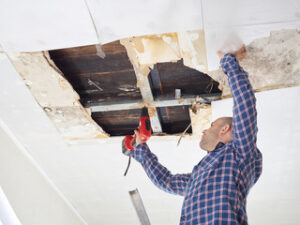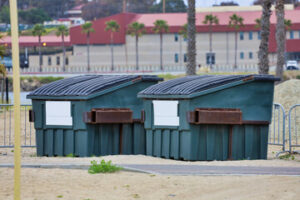Ceilings are a crucial part of any home or building. When they become damaged, it’s important to hire professionals at Ceiling Repair Perth. They can address structural issues, repair cracks and holes, and restore a room’s appearance.

For example, water damage on a ceiling requires immediate attention to prevent the spread of mold and stop structural damage. It also involves identifying the source of the moisture and drying affected materials.
Cracks in ceilings can be alarming and while not always serious, they should never be ignored. They can signal structural damage, a build up of moisture, or simply the natural settling of your home.
If your cracks are accompanied by water damage or severe discoloration, it may be necessary to call in a professional. Repairing these types of issues can be a complex job that requires the use of powerful tools and ladders.
Hairline cracks are often cosmetic and easy to repair. They may also be a sign that a joint wasn’t taped properly, but can easily be disguised using a layer of drywall compound. If the cracks appear in areas with heavy light fixtures or beams, it may be necessary to replace these supports. Replacing these support beams is a significant job that requires the expertise of professional structural engineers and can cost upwards of $1,500.
Small spiderweb cracks usually appear as a result of poor workmanship and can be patched by an experienced DIYer, however, they may indicate foundation settlement which could have serious implications. Cracks that run from the ceiling to the wall are more likely caused by a roof truss uplift and should be addressed immediately.
Before you start repairing any cracks, it’s important to move clutter and furniture out of the way. You’ll also want to put down a sheet of plastic or drop cloth to catch dust, wet mud, and paint drips. Next, place a ladder where it will be stable and practice ladder safety to avoid a DIY disaster before you even get started. Lastly, don’t forget to wear protective eyewear and a face mask to protect yourself from billowing dust.
Clean the area around the crack, then scrape away any loose plaster or drywall to widen the crack. Scrape a little more, then use a utility knife or five-in-one tool to pry any loose debris away from the ceiling. Once the crack is cleaned, it’s time to mix some quick setting drywall compound and apply it. This compound is a bit thicker than regular joint compound so it will fill in the crack more, hiding any imperfections and creating a smooth surface. Once it dries, apply a layer of regular joint compound over the top to finish.
Water Stains
Water stains on the ceiling are more than an eyesore—they can be a warning sign that you may have a leaking roof, damaged plumbing or excessive humidity in your home. Addressing these issues promptly is critical to preventing extensive damage and saving money. Water stains are also a good indicator of where to start looking for the source of the problem.
While you should always consult a professional for serious leaks, you can try to remove brown water stains yourself by cleaning the discolored area and addressing any mold or mildew that is present. Bleach or vinegar solutions are best for removing discoloration and killing the mold that causes it, but you should first test the cleaner on a hidden area of your ceiling to ensure it does not damage or stain the surface.
If the stains are close to an attic vent, skylight or dormer, they likely originate from a roof leak. But if they are in an area of the house with poor ventilation or high moisture levels, it’s more likely that the stains are due to condensation. If the stain feels damp and has signs of mold or mildew, this is another sign that condensation is the culprit.
Once you have identified the source of the stains and repaired or mitigated it, you can begin to remove the discoloration and prep the area for painting. A thorough cleaning is necessary before re-painting to ensure the primer and paint will adhere properly. Using a homemade bleach solution (one part bleach to three parts warm water), or a commercially prepared cleaner, apply the solution liberally to the stained area of the ceiling and scrub the area thoroughly with a clean rag. Once the area is clean, wait a few hours for it to dry.
If you’re planning to re-paint the ceiling, choose a primer and paint that are designed to block tough stains and odors. Purchasing a tester can of the same color to mix into your new coat of paint is a great way to help match a faded ceiling, too.
Drywall Repair
Anytime physical damage occurs to a wall or ceiling, some kind of repair is required. With smaller holes or cracks, this can be as simple as filling with spackle and smoothing with a putty knife before painting over. However, larger damages require a more involved drywall repair process. Silva uses a smart method for repairing large holes in drywall that creates a strong and long-lasting repair without much effort.
Begin by removing any loose drywall from the damaged area. Place a drop cloth or tarp on the floor to catch any water that may drip when you pull down drywall and to protect the flooring from damage. Strap on your hard hat and goggles to protect yourself from debris and dust while you remove the drywall. You’ll also want to put a bucket or plastic tote on the floor to catch drywall pieces and nails that fall as you rip it down.
After you have removed the old drywall, use a utility knife to cut around any electrical wires or pipes that might be in the way of your drywall repair. This can be a bit of a challenge if the wires are in the middle of the drywall sheet and not easily accessible. If you’re not comfortable using a utility knife, consider hiring a professional for your drywall repairs.
Next, draw a joist map on the ceiling with a pencil to determine where the studs are located and what’s above them. It’s important to do this so that you can avoid hitting a water pipe, air duct or any other kind of utility in the ceiling above you. Once you know where the joists are, you can begin tearing down the damaged drywall.
Once you have the hole patched, cover it and the surrounding drywall with a layer of mesh joint tape to strengthen the patch and prevent shifting. Then, using a putty knife, apply a thin coat of joint compound to the entire surface of the patch and surrounding drywall, adding a second layer if necessary. Skim coat to make sure that the compound is smooth, and leave it to dry overnight before painting.
Painting
Painting your ceiling may be low on your to-do list, but a fresh coat of paint can make a room look brighter and more inviting. If you have a water-damaged ceiling, though, it’s important to fix the damage before attempting to repaint. Otherwise, the new paint could chip or peel away in the same way as the old one, exposing drywall to further damage.
To repair a damaged ceiling before painting, start by cleaning the surface with mild dish soap and water. Mix a scrub sponge with the soapy water and lightly clean the entire surface. Then, dry it with a clean, lint-free cloth. This step is especially crucial if you’ve had a leak in the past. After the surface is dry, you can apply a patching compound to the cracks and holes. Use a putty knife to spread the mixture over the area, then let it dry overnight. Once it’s dry, sand the patched area to smooth it and blend it with the rest of the ceiling before priming it.
Once the patched and primed area is ready to be painted, you can use high-quality ceiling paint that’s formulated for plaster surfaces. Using the right type of paint will help ensure that your new coat will last for years to come. If you’re concerned about the quality of your paint job, consider hiring a professional to handle the task.
Many of the most common problems with a ceiling stem from moisture, so preventative measures are key to keeping them in good condition. Inspect your ceilings regularly and keep an eye out for water stains, cracking, or sagging. Addressing these issues quickly can prevent the damage from worsening and save you money in the long run.
In the event that you do encounter ceiling damage, the above tips can help you repair and repaint your drywall quickly and easily. But for serious issues, like structural damage or mold growth, a contractor is the best choice. Enter your zip below to get matched with top-rated pros near you. Home repair can be daunting, but with the right information you can tackle even the most complex projects.


